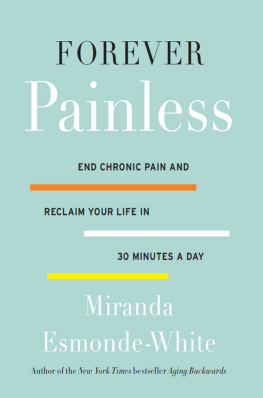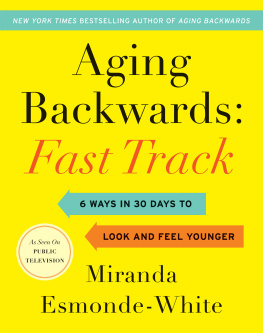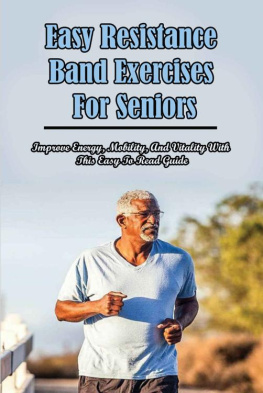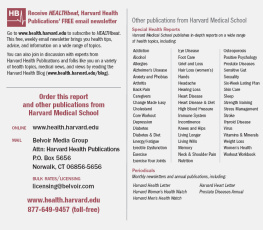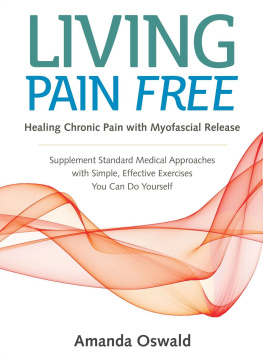This book is dedicated to my daughter, Sahra Esmonde-White, and all the hardworking staff at the Essentrics office who made it possible.
Contents
Guide

C hronic pain can result from many different causes, but once pain becomes chronic, life becomes very difficult. One of the most damaging consequences of pain, whatever or wherever its origin, is the tendency to stop moving. We stop moving because it hurts to move, or because we fear that movement will make things worse, or because were too exhausted even to think about moving. But the reality is that being sedentary only worsens chronic pain, and initiates a downward spiral that prevents us from recovering: As we move less, our muscles become weak, our connective tissues stiffen, our posture deteriorates, and our stamina decreases. Consequently, any type of physical activity becomes even more difficult. On the other end of the spectrum, programs that encourage people to push through the pain with repetitive exercises cause muscle strain and inflammation, prolonging chronic pain and making it worse. Soon discouragement sets in.
With her deceptively simple exercise program, Essentrics, Miranda Esmonde-White offers a hopeful alternative for the millions of people who suffer from chronic pain. Essentrics uses a simple technique that can gently interrupt and reverse the cycle of pain and physical deterioration. The beauty of the program is its balance of stretching, strengthening, posture, and cardiovascular work. Most important, it leaves no stone unturned, as every part of the body from the fingers to the toes receives attention, restoring harmony and bringing the body back in tune with itself. The emphasis on relaxing tight muscles while performing whole-body movements allows more and more of the body to participate, as tight and painful areas are able to let go and stop sending pain signals.
In my personal experience of doing Mirandas program for the past three years, I have become noticeably stronger and more flexible, never once experiencing any aggravation of pain the day after a workout. This is significant for me, as I have a long history of chronic pain. For more than twenty years, every physical treatment or exercise I ever tried either did not work or made the pain worse. But after doing this program, my chronic pain is now gone.
To develop Essentrics, Miranda Esmonde-White used her basic training in classical ballet as a starting point, and supplemented it with conventional physiotherapy, tai chi, and a wide variety of other disciplines she had gleaned from her lifelong studies. In her popular public television series Classical Stretch, which has been on the air since 1999, she is a delightful coach, encouraging and coaxing viewers with grace and humor. Just watching her move so beautifully, even when she is well into her sixties, is an inspiration. Now in this book, she explains in detail the rationale underlying her exercise program and how it may benefit anyone who suffers from chronic musculoskeletal pain.
My own research on connective tissue suggests that gentle stretching is an essential part of any treatment protocol for chronic pain, as it reduces inflammation and helps heal injuries. Essentrics exercises are gentle but powerful, and come with the explicit instruction to go slowly and change one cell at a time. This is an especially important point when it comes to working with our connective tissues, also known as fascia, which can easily be injured by excessive or rapid stretching.
I look forward to the day when we will have a research study that measures the effects of Mirandas incredible program. In the meantime, we are fortunate to have this treasure of a book, and it is up to each of us to make use of it.
Helene M. Langevin, MD
Professor in Residence of Medicine
Director, Osher Center for Integrative Medicine
Brigham and Womens Hospital, Harvard Medical School

T he experience of pain can disrupt our lives on a day-to-day, minute-to-minute basis. The amount of mental, emotional, and physical energy necessary to battle chronic pain can leave us exhausted and demoralized, with little hope for relief. Relationships suffer; jobs are lost. Pain limits our possibilities, shrinks our world, clouds our perceptions, and leaves us less engaged with our families and in our lives.
But when were able to find relief from pain, the whole world changes. Once fearful of movement, we can return to and enjoy our favorite activities, from taking long walks to playing tennis to running around with our children or grandchildren. Without the mental and physical distraction of pain plaguing us, we can be present and enjoy our time with loved ones. We can forgo dependence on others and reclaim our independence, our freedom. We can once again carry our own groceries, walk up and down stairs, and tend to our own gardens. Our lives, once dimmed by pain, become brighter and full of promise.
Sound too good to be true? Its not. I promise you, healing from chronic painan actual cure for your painis possible. Unfortunately, the current medical approach to treating pain is not to heal it, but to manage it. Chronic pain is seen as something to be minimized or muted or coped with, rather than to be permanently fixed. In an effort to rescue their patients from pain, many doctors primary focus has been on providing immediate relief through pharmaceuticals. But we now know that short-term solutions, though temporarily effective, carry tremendous risk.
Today America is in the midst of an opioid addiction epidemic that has quadrupled in the last decade, claiming lives on a minute-by-minute basis. Drug overdoses have become the leading cause of accidental death in the United States, and opioids have driven this epidemic. In 2014 alone, almost nineteen thousand overdose deaths were linked to prescription pain relieversalmost twice as many deaths as those linked to heroin. Despite their widespread use, opioids provide only fleeting relief from pain, with patients quickly building up a tolerance. Our quest for a quick fix has left us in the midst of an ever more dangerous public health crisis and, tragically, much further from the true pain cure we need.
Thankfully, in recent years, neurologists have begun to uncover evidence that we can, indeed, heal from painnot just block it or mask it. And as with many forms of healing, the most powerful natural remedy does not come in the form of a pillit comes from within our own bodies.
Correct Exercise Is the Silver Bullet
W e know that we need to exercise to stay fit. Your doctors have likely encouraged you to exercise regularlybut their suggestions were probably focused on promoting heart health, balancing your blood sugar, or helping you lose a few pounds. We are told, simply, that exercise is goodwe should all just do some exercise, any exercise, to remain healthy. However, such general recommendations do nothing to address the issue of healing pain. In fact, though this guidance may be well intentioned, the lack of specificity is a problem. When exercise programs are taken to an extreme, they are often counterproductive, aging the body and laying the foundation for chronic pain.
Its time for a new approach. We need to recognize that how we exercise matters. Rather than unquestioningly follow the

